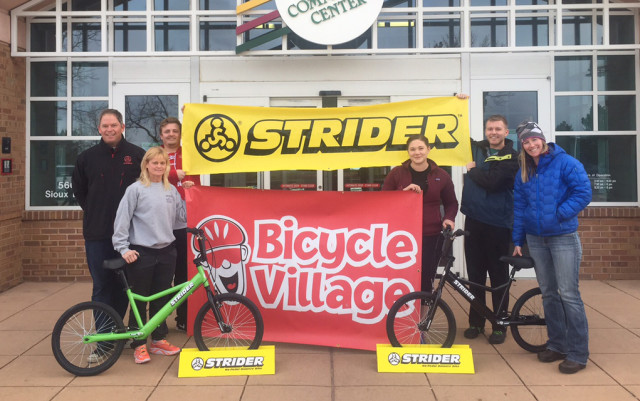
As biking becomes more popular, bike technology gets more advanced. Built on carbon frames with titanium cranksets, hydraulic disc brakes and 3-D printed saddles, bikes are evolving into technological masterpieces. But sometimes the most meaningful innovation happens through simplification.
Remove the pedals, cranksets and the chains. Just leave the frame, the handlebars, two wheels and the saddle. What remains is a balance bike, or a velocipede as they would have called it in 19th-century England. Self-propelled with alternating strides, riders naturally find their balance as they lift their feet off the ground to glide.
These bikes, recently re-popularized by Strider Sports International, expedite the process of learning how to ride on two wheels. Until recently, this tool was exclusively available to younger kids, 18 months to five years old, because there was only one small frame size in production. But Strider recently changed all that by building bigger frames for teenagers and adults. The only problem was that there was very little demand for the product.

“We decided to go for it anyway,” says Marty Martinez, a representative for Strider. “The niche is so small, and we knew we would probably lose more money than we make in these bikes, but the reward outweighed the cost. Everyone should be able to have the fun of two wheels. If you can stand up you get to do this.”
The value the company saw sat in stacks of letters from parents of kids with special needs, asking what to do now that their children had outgrown the smaller bike. Did that really mean they had to get training wheels for their now teenage children? Or attach a push handle for a caretaker to hold them upright?
At this point, adding a crutch felt like a step backwards, parents wrote. After seeing the improvements in the confidence of their children, after watching them balance when experts told them it wasn’t possible, people pleaded with Strider to help them find a way to maintain the newfound mobility for their growing children.
In January, Boulder’s Exciting Programs, ADVENTURES & New Dimensions (EXPAND), which has been around for 35 years, launched a new Strider pedal-less bike program for teens and adults with developmental disabilities. Participants gather a few times a week in a gym to practice moving on the bikes as they progress through terrains and gain environmental awareness. The gym time prepares them to take bikes into the world.
Sherri Brown, therapeutic recreation coordinator for the City of Boulder for the past 21 years, immediately recognized the unique opportunity opened up by the adult-sized frames and eagerly launched the program.
“In the other programs I run I am so aware of the lack of confidence of the participants,” Brown says. “That is so tied up in balance. Where for some people it is really easy to stand on one foot, for these guys it is more of a struggle. My priority is to truly see them work on that balance and confidence.”
One of the program participants, Sarah, and her caretaker Bethany Silkensen, are realizing that benefit. Trepid around bikes her entire life, Sarah at first hesitated just to stand over the frame, but after only a few half-hour sessions she is already moving on her own as she finds her balance and grows her confidence.
“Sarah needs help walking up stairs, she has trouble balancing,” Silkensen says. “And that she can be on the bike by herself is liberating. She can move and she can turn, all on her own.”
As Sarah and the other riders find their independence, they also offer insight into the roles of the caretaker, teaching Silkensen how to let go in order for Sarah to discover what she is truly capable of.
“She only fell one time, when I was trying to force her to turn,” Silkensen says. “I had put my hands on the handlebars to get her to turn and she wasn’t ready, so she kind of collapsed into my arms. Not hurt at all, she started laughing and I looked at her and said, ‘I am sorry, Sarah. I will let you do your own turns from now on.’ It was a lot easier for her to be in control of the turns than to have me to help.”
EXPAND’s program is the first of its kind in the state, but joins a growing movement as Special Olympics incorporates balance bike competitions into major festivals and games around the world. As the popularity of balance bikes increases among adults with developmental disability and anecdotal evidence accumulates, research studies are beginning to confirm the value to participants.
Dr. Andrew L. Shim, director of the Department of Kinesiology & Human Performance at Briar Cliff University, located in Sioux City, Iowa, is studying the relationship between riding pedal-less bikes and balance in children with autism. His early findings confirm a correlation between riding and improvements in lateral stability among participants, which led to the creation of a curriculum to assist in that gain. His work will be published this April in the Journal of Physical Education, Recreation and Dance.
Shim studied two sets of variables: the center of pressure, a measurement of balance taken with eyes closed standing on a flat ground and then on a perturbed surface; and the limit of stability score, a measurement of balance taken by leaning forward, backward and then side to side. It was in the later limit of stability category that Shim found significant improvement, with stronger evidence on the right lateral or dominant side. He also found overall improvements in stability while the children were moving on the bikes.
“It isn’t as simple as saying that Strider bikes caused the improvement,” Shim says. “It is the opportunity that the bikes provide, to let participants challenge their central nervous system, to understand a little bit more about freedom and stability control. Secondly, the study was done on challenging terrain, uneven surfaces and slopes, encouraging the children to work a little bit harder at times than they are used to. Raising the expectation might have played a factor.”

Shim says the goal is not to catch people with special needs up to other riders, but an attempt to help them become more comfortable being active. Balance is a portion of it, but a lot of it, he says, is confidence and opportunity.
To ensure that people with disabilities have that opportunity, Strider started the 1% Rider Fund, contributing 1 percent off the top of company profits to fund the startup of community programs, offer discounts on bikes and match community contributions for program upstarts.
“Boulder is such an embracing community and that’s what I love about the vibe in the city. It doesn’t matter what, who or why you are here as long as you are active,” Martinez says with a laugh.
With the EXPAND program, Martinez says, even more people can enjoy “the cycling Mecca of Boulder in their own way.”
To further encourage growth in ridership, Strider is talking with Valmont Bike Park in North Boulder to incorporate a balance bike race as early as this summer. Although Brown and EXPAND did not set out to include competitions, they are eager to look at every opportunity to open the community’s eyes to the difference these bikes can make.
“Maybe we don’t have a specialized race,” Brown says. “Maybe we have a beginner bike race that [balance bikes] can be allowed into. And maybe there is another teen out there that would rather ride a strider bike than a pedal bike. Sometimes within a race you can have very different levels of competition or prizes, and you can all still race at the same time. It’s just that there are different ways of winning.”














